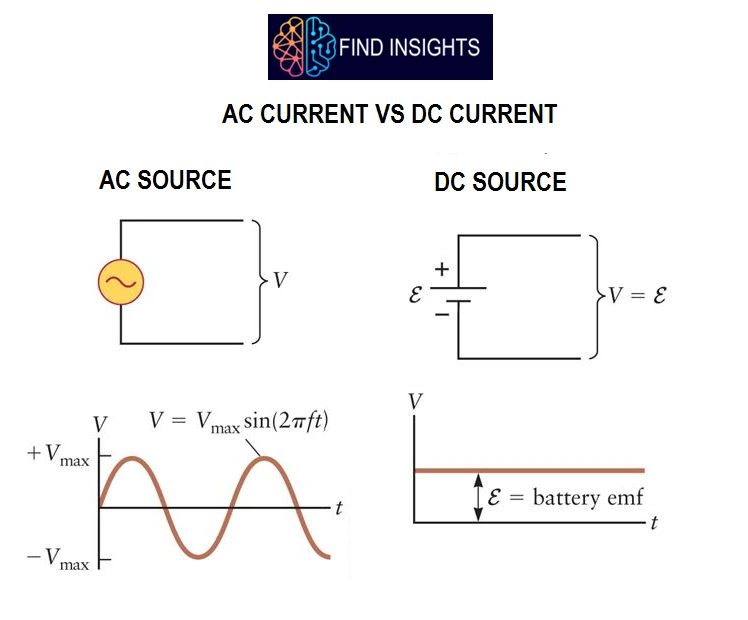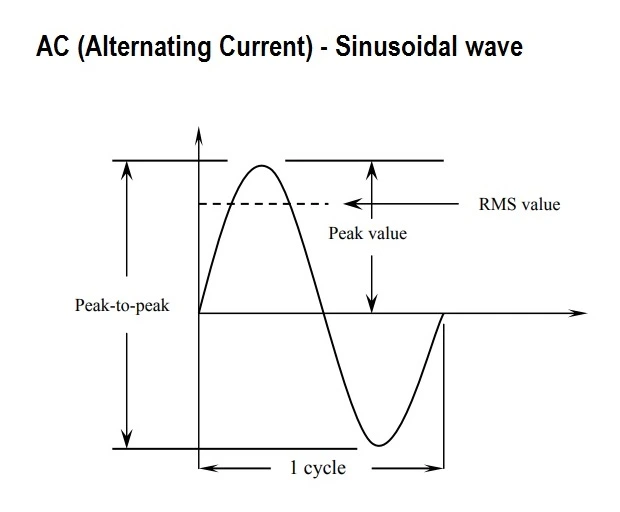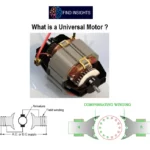
AC CURRENT VS DC CURRENT
AC means Alternating Current and DC means Direct Current. In his article let’s see the difference AC Current Vs DC Current
Alternating Current (AC)
- Alternating Current (AC) flows one way, then the other way, continually reversing direction.
- Alternating current (ac) circuit carries a basically sinusoidally time varying current; the amplitude of which may vary.
- An AC voltage is continually changing between positive (+) and negative (-). The rate of changing direction is called the frequency of the AC and it is measured in hertz (Hz) which is the number of forwards-backwards cycles per second.
- Today, most of the electrical devices we use require ac voltage. This is mainly because most of the electrical energy sold by power companies is transmitted and distributed as alternating current. The main reason for preferring use of ac voltage over dc voltage is that ac voltages can be easily and also efficiently converted from one voltage to the other by means of transformers. Further, electrical energy can also be transmitted economically over long distances.
SINUSOIDAL WAVEFORMS

- AC unlike DC flows first in one direction then in the opposite direction. The most common AC waveform is a sine (or sinusoidal) waveform. Sine waves are the signal whose shape neither is nor altered by a linear circuit, therefore, it is ideal as a test signal. In discussing AC signal, it is necessary to express the current and voltage in terms of maximum or peak values, peak-to-peak values, effective values, average values, or instantaneous values. Each of these values has a different meaning and is used to describe a different amount of current or voltage. Figure shows a sinusoidal wave. The correspondence mathematical form is v(t) = V (wt +θ )
Direct Current (DC)
- Direct Current (DC) always flows in the same direction, but it may increase and decrease. The current is basically constant but the magnitude may vary.

- A DC voltage is always positive (or always negative), but it may increase and decrease. Electronic circuits normally require a steady DC supply which is constant at one value or a smooth DC supply which has a small variation called ripple. Cells, batteries and also regulated power supplies provide steady DC which is ideal for electronic circuits.
SOURCES – AC Current Vs DC Current

A.C. source:
Any source that produces alternating voltage continuously and has ability to deliver the alternating current is called a.c. source such as alternators, oscillators or signal generators.
D.C. source:
Any source that produces direct voltage continuously and has ability to deliver direct current is called d.c. source such as batteries and generators etc.
AC Current Vs DC Current – Advantages & Disadvantages
Alternating Current (AC):
Advantages:
- Simpler to transmit since generators at the power plants produce AC Voltage and currents
- Greater power can be generated using turbines
- Can be transmitted over long distances easily
- Readily Scalable to any desired voltage
- Power can flow it two directions (Positive and also negative)and a number of different phases (2-phase, 3 phase)
Disadvantages:
- More dangerous to transmit than DC.
- Requires transformers and substations.
- Causes electromagnetic interference
Direct Current (DC):
Advantages:
- Reactance: DC system does not introduce a reactance in the line.
- Power: In DC system, the power is just the real component.
- Frequency: In DC system, the frequency is zero, thus no frequency variation to monitor.
- Analysis: Analysis of AC system always involved complex numbers, while DC is only a real number, thus simplifying the analysis
- NO skin effect.: A DC system has no skin effect so we can utilize entire cross section area of line conductor
Disadvantages
- Unable to scale voltages and current sufficiently.
- Large amounts of power are lost due to the resistivity of the wire in long distance DC transmission
Applications – AC Current Vs DC Current
- AC Current – Most of the household, industrial and also commercial equipment operate on DC.
- DC Current – Cell phones, Electric Vehicle, Electroplating, Flashlight, etc.
LIKE WHAT YOU’RE READING?
CHECK OUT SOME OF OUR OTHER GREAT CONTENT HERE:
- SYNCHRONOUS MOTOR STARTING METHOD
- WHY THE SYNCHRONOUS MOTOR IS NOT SELF STARTING
- LVDT- CONSTRUCTION, WORKING PRINCIPLE , APPLICATIONS, ADVANTAGES, AND DISADVANTAGES
- HOW AN IGBT WORKS?
- SCR VI CHARACTERISTICS EXPLAINED IN DETAIL
- STEP UP TRANSFORMER: DEFINITION, CONSTRUCTION, WORKING & APPLICATIONS
- LIMITATIONS OF OHM’S LAW
- INDUCTION MOTOR: WORKING PRINCIPLE, TYPES & APPLICATION
- STRAIN GAUGE WORKING PRINCIPLE
- WHAT IS THE ZENER DIODE? – EXPLAINED
- WHAT IS OPERATING SYSTEM AND ITS TYPE
- WHAT ARE THE USES OF CAPACITOR
- WORKING OF AN INDUCTOR – EXPLAINED
- CHARACTERISTICS OF A ZENER DIODE – EXPLAINED
- VOLTAGE REGULATION BY ZENER DIODE – EXPLAINED




5 Comments